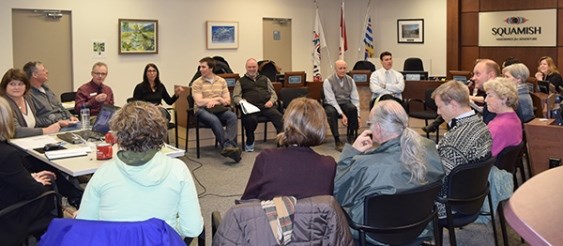The 2016 budget sets a 4.8 per cent tax revenue increase, which amounts to about $1.1 million in additional revenue over 2015.
Council passed three readings of the 2016-2020 financial plan bylaw Tuesday night.
The revenue increase does not mean that an individual’s property taxes will increase by 4.8 per cent, according to Linda Glenday, district chief administrative officer. Tax rates will be set in April following the BC Assessment revised roll, she said.
“The actual tax increase will be very different than the 4.8 per cent,” said Mayor Patricia Heintzman. “We anticipate it will be just under three [per cent], based on preliminary analysis of B.C. Assessment.”
Homeowners’ individual tax increase will depend on several factors including assessments.
Utility rates for 2016, which were set in December, include a four per cent increase to the water rates, two per cent to the sewer rates and 12.7 per cent increase for solid waste fees, based on a medium-sized garbage can.
For the 2016 budget, 48.93 per cent of the revenue comes from taxation – amounting to $24,454,018; the provincial average is 46.29 per cent, according to documents. Fees for services account for 24.44 per cent of the revenue for this year’s budget, while the provincial average is 31.48 per cent.
Transfers from other levels of government account for 7.87 per cent of revenue. Developers contribute 8.99 per cent of council’s budget revenue for 2016.
The total from all funding sources in the 2016 budget is $65,297,941.
Councillor Ted Prior voted against the budget Tuesday night. He objected to forecasting revenue increases in the years 2017-20.
“I would like not to plan an increase next year,” he told his fellow councillors, who appeared shocked at his statement. “I can’t support it.”
Before the vote, Heintzman said there would be revenue increases in future years, but it was yet to be determined if there would be tax increases. “Increases are bargaining agreements that are already in place, they are requirements with RCMP contracts – a whole bunch of different things drive the increases. So if growth keeps pace with the requirement for a revenue increase, there won’t be a tax increase.”
Glenday added during next year’s budget process, the forecast tax revenue increase can be reconsidered.
The 2016 budget includes a total of about $2.4 million for alternative transportation projects, including Corridor Trail South, and $1.27 million for the Brennan Park Arena slab replacement. The Official Community Plan review, to be completed this year, is budgeted for about $224,000.
Approximately $8.2 million of the 2016 budget is slated for the district’s portion of the construction of the Oceanfront’s Peninsula Main Road.
Community groups will receive close to $281,000 in grant in aid and in-kind support in 2016. The amount includes a preapproved $40,000 to Squamish BMX for realignment of its track; $65,000 to Squamish Off-Road Cycling Association (SORCA) for trails; $25,000 to Squamish Arts Council to launch a dedicated art space, conditional on the group securing such a space and $10,000 for other projects; $15,000 for Squamish Helping Hands to renovate the kitchen at the shelter; $11,500 for the DSBIA; $10,000 for the Howe Sound Women’s Centre and $5,000 for Squamish volunteer cancer driver program.
Public engagement on the budget included information on the district website, a survey that was completed by 45 people and a community town hall meeting.



